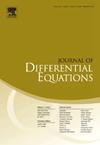Global existence and optimal decay rates of strong solutions to the equilibrium diffusion model arising in radiation hydrodynamics
IF 2.3
2区 数学
Q1 MATHEMATICS
引用次数: 0
Abstract
In this paper, we investigate the global existence and optimal decay rates of strong solutions in the critical Sobolev space to the equilibrium diffusion model arising in radiation hydrodynamics. This model is composed of the full compressible Navier-Stokes equations with radiation diffusion terms. Assuming that the initial data is sufficiently small in -norm, we establish the global existence of strong solutions near the equilibrium state by applying the refined energy method. Then, by performing Fourier analysis techniques and exploiting the frequency decomposition method, we get the optimal time-decay rates of strong solutions (including the highest order spatial derivatives) in -norm. In particular, the lower bound of time-decay rates of strong solutions is also obtained by making use of Hodge decomposition, delicate spectral analysis and the theory of Besov space. In addition, we obtain the exponential decay of strong solutions in the periodic domain case.
辐射流体动力学中平衡扩散模型强解的整体存在性和最优衰减率
本文研究了辐射流体动力学中平衡扩散模型在临界Sobolev空间H2(R3)中强解的整体存在性和最优衰减率。该模型由带辐射扩散项的全可压缩Navier-Stokes方程组成。假设初始数据(n0,u0,θ0)在h2范数下足够小,我们应用精细能量法建立了平衡态(1,0,1)附近强解的全局存在性。然后,通过执行傅里叶分析技术和利用频率分解方法,我们得到了l2范数强解(包括最高阶空间导数)的最佳时间衰减率。特别是利用Hodge分解、精细谱分析和Besov空间理论,得到了强解时间衰减率的下界。此外,我们还得到了周期域情况下强解的指数衰减。
本文章由计算机程序翻译,如有差异,请以英文原文为准。
求助全文
约1分钟内获得全文
求助全文
来源期刊
CiteScore
4.40
自引率
8.30%
发文量
543
审稿时长
9 months
期刊介绍:
The Journal of Differential Equations is concerned with the theory and the application of differential equations. The articles published are addressed not only to mathematicians but also to those engineers, physicists, and other scientists for whom differential equations are valuable research tools.
Research Areas Include:
• Mathematical control theory
• Ordinary differential equations
• Partial differential equations
• Stochastic differential equations
• Topological dynamics
• Related topics

 求助内容:
求助内容: 应助结果提醒方式:
应助结果提醒方式:


